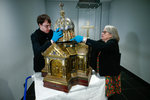



At the beginning of March, it would have been quite a challenge to find a Catholic who had ever heard of St. Corona, to say nothing of finding one who had prayed to her. Since the onset of the global COVID-19 pandemic, however, the second century martyr has attained a newfound prominence online: social media posts mentioning her have gathered thousands of shares, and several secular news outlets have even gone so far as to proclaim her “the patron saint of pandemics.” In short, she appears to have suddenly gone viral (if you will pardon the expression).
But who exactly was St. Corona, and what connection does she have with the virus that shares her name? The answers, unfortunately, are a bit murky.
“Like so many of the early martyrs, we really know little about St. Corona besides her name and the method of her execution,” says Elizabeth Harper.
Harper is a professor at the University of Southern California and the writer of “All the Saints You Should Know,” a popular blog on relics and hagiography.
In a recent article for Slate, she attempted to trace the origins of St. Corona's sudden explosion in popularity. She discussed her research in an interview with Rhode Island Catholic.
“The earliest reliable English source about Corona that I could locate was a 1916 edition of “The Roman Martyrology,” Harper explains. The Martyrology is the official catalogue of saints recognized by the global Church; the 1916 printing identifies May 14 as the Feast Day of Saints Victor and Corona.
The entry is remarkably brief: it states that Victor was a Roman soldier in Syria who was martyred for his Christian faith during the persecutions organized by Emperor Antoninus Pius. Corona was in the crowd at the public execution, where she experienced a vision of two crowns descending from heaven — one for Victor, and another for some other individual who was about to die for Christ. When she described the revelation to those around her, she was accused of also being a Christian and was martyred by being “torn to pieces between two trees” (apparently meaning that she was tied to the ends of two palm trees which had been bent down, and was then torn apart when the trees were released).
According to Harper, Corona's vision also contains the key clue to her name.
“In this period, it was common for martyrs to be canonized with a name which either reflected some virtue which they were a model of — as happened, for instance, with Saints Faith, Hope and Charity — or else to be given a name which referred to their life in some other way,” she says. In this case, “Corona” is the Latin word for “crown.”
She is not the only saint whose name derives from their receiving the “crown of martyrdom.”
The name of St. Stephen, the Church's first martyr, comes from the Greek word stephanos, meaning crown – which explains why the exact same St. Corona is venerated by the Greek Orthodox under the slightly less exotic name of “St. Stephanie.”
The common name overarching the COVID-19 strain of the pandemic, coronavirus has a similarly royal etymology.
When scientists first viewed the general virus under an electron microscope in the 1960s, they gave it a name which reflected the large prongs which seemed to extend from it, giving it a superficial resemblance to a crown.
“It's easy to look at the similar names and think that there's some kind of supernatural connection between St. Corona and the virus,” Harper says, “but the relationship really isn't that odd when you look at their origins.”
So far, so good – but what about the claim that St. Corona is the patroness of pandemics?
The record here is a bit harder to evaluate.
In her research, Harper traced the online origins of the now widely-shared claim to a post on the German website Gloria.tv, which continues to promote itself as a Catholic news source despite having been formally denounced by the German Bishop's Conference. The specialty of the site appears to be manufacturing misleading articles about German Chancellor Angela Merkel, and some online sources have suggested that its claims about St. Corona are similarly dubious.
Snopes recently declared the claim to be “false," citing a statement from Boston College professor and Hagiography Society President Catherine M. Mooney, who said that “Saint Corona has not been known as the patron saint of pandemics.”
The story may be somewhat more complicated than a simple case of wishful misinformation, however. In a recent statement to Reuters, a representative for the Cathedral of Aachen indicated that there is a tradition specific to Germany of invoking St. Corona for protection against plagues, in addition to calling upon her for the protection of lumberjacks (a patronage stemming from the circumstances of her martyrdom). The German cathedral actually houses the relics of St. Corona, which it has taken out of storage and is preparing to display for public veneration, saying that the virus has brought renewed interest in the formerly obscure saint.
It is difficult to say how widespread the association between St. Corona and disease was before the current COVID-19 pandemic gripped the world's attention.
What is clear, however, is that interest in and devotion to the saint has increased dramatically over the past several weeks — especially in Rhode Island. A glance at Google trend statistics indicates that searches for “St. Corona” have skyrocketed since the week of March 8, and that Rhode Island has had one of the highest search rates for the term in the entire country.
Several Catholics throughout the nation have seized upon the opportunity to invoke St. Corona for their own COVID related concerns.
In New Mexico, for instance, Catholic artists whose livelihoods have been affected by the pandemic have organized a digital art show scheduled to take place on her upcoming feast day, with icons and other imagery of the saint being the principle attraction.
Sean Wells y Delgado, a fifth-generation Spanish colonial artist who practices the retablo style of iconographic art, recently spoke to Rhode Island Catholic about her involvement with the show.
“I did as much research as I could about St. Corona,” she says.
“I really wanted to make sure that the patronage was real before I started the artwork.”
In her investigation, Wells uncovered a surprisingly local connection between the saint and New Mexico's cowboy culture.
“Apparently, pilgrim cattle farmers would invoke St. Corona to protect their herds from disease,” she explains.
In her retablo icon of St. Corona, Wells found subtle ways to reference the ongoing pandemic – particularly in the saint's halo, which is designed after the microscopic “crown” that gave the virus its name.
Another Catholic group calling upon the saint's patronage is the Priestly Fraternity of St. Peter, which has recently organized what they are calling the “Saint Corona Project.”
A part of their ongoing “iMass” initiative, the project is an app-based live stream service for individuals who cannot attend Mass at their accustomed parish due to the quarantine.
In a recent interview, a representative for the organization said that the title was chosen because St. Corona “had been invoked for the plague in years past, and we felt that she could be a fitting patron for this project of helping other parishes and parishioners in this time.”
According to Dr. Arthur Urbano, a theology professor at Providence College, all of this is part of the dynamic process through which saints acquire the reputation of having a certain patronage.
“Early Christians sought the miraculous intercession of the saints for healing and other life situations,” he says, “but there were no designated patron saints for specific illnesses or other ailments as such... As people reread, retold, and reheard ancient martyrdom accounts and lives of the saints, certain key aspects of their stories leapt out that led to associating that saint with a specific ailment.”
Whether or not the new patronage will stick for St. Corona remains to be seen.
In the meantime, it certainly doesn't hurt to spend some time reflecting on a courageous young woman who gave her life for the faith — and if we can also enlist her aid against the ongoing pandemic, so much the better.